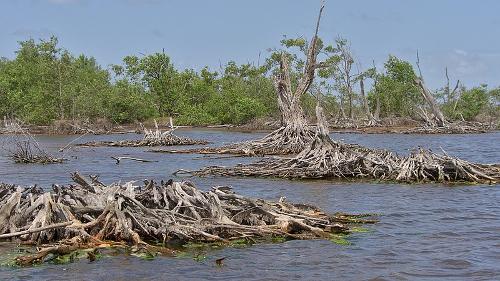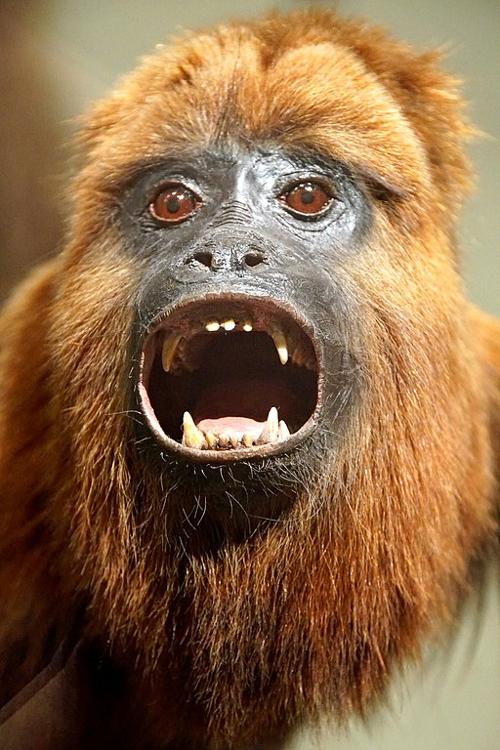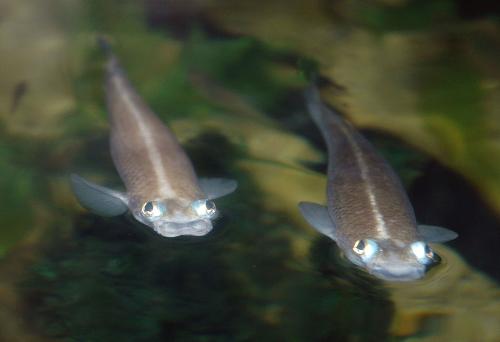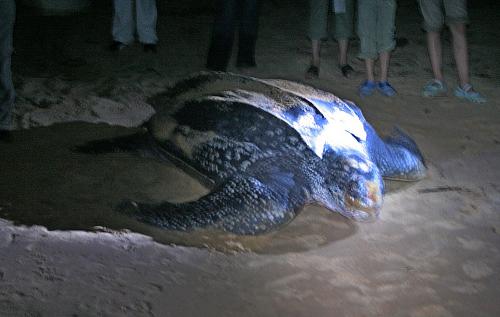SURINAME
Plants and Animals

Plants and Animals
Plants and Animals
Plants
 Mangroves SurinamePhoto: Rob Oo CC 2.0 Generic no changes made
Mangroves SurinamePhoto: Rob Oo CC 2.0 Generic no changes made
Suriname has tropical vegetation. The vegetation is closely related to that of the neighboring Guyanas and to the Amazon region.
The number of species of plants is about 5000. For an area of this size and without high mountains that is quite a lot. Some common varieties are the Butterfly Flower family, Walstroke family, Euphorbia family, Palms and further Grasses, Bromeliads, Cacti and beautiful Orchids.
Characteristic for Suriname is the coastal forest that consists of mangrove (tidal forest), with mainly the Parwa. The national flower of Suriname is the palulu or Heliconia bihai. Suriname's national tree is the royal palm.
Animals
 Howler Monkey SurinamePhoto: Dennis Jarvis CC 2.0 Generic no changes made
Howler Monkey SurinamePhoto: Dennis Jarvis CC 2.0 Generic no changes made
The animal world is of a tropical South American character and mainly includes the fauna of the tropical rainforest. The animal world is still full of surprises. The mammals comprise about 140 species, including 8 types of monkeys (including howler monkeys and capuchin monkeys) and 14 types of predators (including jaguar and puma). The bats are well represented with 65 species (including the bloodsucking vampires). Furthermore, there are three types of anteaters, two types of sloths and five types of armadillos (including the giant armadillo).There are also the South American tapir and three types of deer. A sea cow species occurs off the coast and in the estuaries.
The bird world is very rich and includes more than 600 species. The migratory birds (mainly waders from the north) comprise at least 60 species. Typical birds include the scarlet ibis, black vulture, toucans and parrots. Amphibians and reptiles have become widely known (amphibian salamanders, the bizarre looking Surinamese toad, poison dart frogs, caimans, crested lizard or iguana, boa constrictor, anaconda, forest master and rattlesnakes among the venomous snakes, and sea, water and tortoises).
 Four-eyed fish SurinamePhoto: James St John CC 2.0 Generic no changes made
Four-eyed fish SurinamePhoto: James St John CC 2.0 Generic no changes made
The fish include many well-known aquarium fish in the fresh water (carp salmon and viviparous tooth carp); especially catfish are abundantly available. The piranhas, electric eel, stingray, four-eyed fish and cichlids deserve special mention.
Lower animals are represented by giant centipedes, tarantulas, land snails that grow to over 13 cm long and an innumerable insect world, including famous butterflies such as Morpho and the curious lantern bearer among the cicada-like bugs.
The coast and the mostly muddy continental shelf are home to a tropical Caribbean fauna, including commercially important fish and crustaceans. Numerous animals are hunted and eaten, especially monkeys, rodents and ungulates; seaturtle eggs are also very popular. Hunting is sufficiently regulated, but in practice it proves difficult to apply the decisions; poaching is an everyday occurrence and some provisions do not apply in parts of the interior.
 Sea Turtle lays eggs in SurinamePhoto: Jan Willem Broekema CC Alike 2.0 Generic no changes
Sea Turtle lays eggs in SurinamePhoto: Jan Willem Broekema CC Alike 2.0 Generic no changes
Sea turtles and their clutches are protected by a mixed system of reserves, quotas and bans. Nature conservation is therefore among the best in South America. In nine reserves spread throughout the country, fauna and flora are reasonably to well protected. A modest nature tourism has emerged from these areas; the best known of these areas are beaches where sea turtles nest, the Raleigh Falls-Voltzberg Reserve, Table Mountain, Sipaliwini Savannah and Brownsberg. The Asian mungo (a mongoose) was introduced at the beginning of this century to control rats and the bushmaster (a poisonous snake); distribution has been limited to date.
In 2007 the Surinamese nature conservation organization CIS (Conservation International Suriname) announced that 24 new animal species had been discovered, mainly in the Lely and Nassau mountains. This mountain range belongs to the Guyana shield, a continuous area of tropical rainforest that includes several countries. Among the newly discovered species are a Dipsas indica, a snail-eating snake, a dwarf catfish and a frog species belonging to the Antelopus genus.
Sources
Beatty, N.B. / Suriname
Chelsea House
Encarta Encyclopedie
Leuwsha, T / Reishandboek Suriname
Elmar,
Noordegraaf, W / Suriname
ANWB
CIA - World Factbook
BBC - Country Profiles
Copyright: Team The World of Info